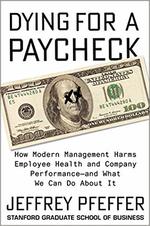 In his shocking book, Dying for a Paycheck: How Modern Management Harms Employee Health and Company Performance – and What We Can Do About It, author Jeffrey Pfeffer recounts the research he and colleagues have done to examine the management practices that establish the expectation that employees must work themselves to death – literally – to advance their careers. Pfeffer, Professor of Organizational Behavior at Stanford Graduate School of Business, firmly establishes the connection between dysfunctional workplace practices and both employee health and organizational performance. It isn’t a pretty picture. More toxic than secondhand smoke exposure
One of Pfeffer’s conclusions is that many workplace practices are more toxic than exposure to secondhand smoke. Although this may seem like an outlandish assertion, the author presents his case convincingly using bar graphs on pages 46-47. In all categories of health effect, secondhand smoke exposure is at the bottom or middle of the rankings, showing that work stressors pose significant health risks for employees and bottom line risks for employers. Although the book pays more attention to the adverse consequences for the employee, the author also points out the accompanying costs to the employer of toxic workplace practices, which include: high attrition, low productivity and engagement, high workers compensation costs, high health care costs and high absenteeism (due to sick leave). He urges workers not to die for a paycheck and recommends that these employees leave these jobs that make you sick. In addition, he recommends many practices that an employer can implement to offset these risks. He also argues for more extensive government regulation, especially in the US, to provide a level playing field for all employees. His argument is that we regulate environmental pollution; therefore, our government should also regulate “social pollution” (p 140), which is the aggregate of toxic workplace practices. Although I found the book to be poorly organized and the author apt to going off on tangents, I highly recommend Chapters 1, 2, 4 and 6 to leaders who wish to examine their workplace to ensure it is a life-enhancing environment. These chapters provide an overview and introduction to the research (chapters 1 and 2), explore the negative effects of long hours and work-family conflict (chapter 5) and the dangers of low job control and too little social support in the workplace (chapter 6). This review will also focus on these aspects of the book. Pfeffer goes on to identify ten workplace practices that adversely affect human health and longevity (p.43). Rather than listing all at this point, we will look at the four practices that leaders today have the most control over:
Toxic Workplace Practice #4: Working long hours in the week In his chapter on the negative effects of long work hours, Pfeffer opens with the story of a Japanese worker who died of a heart attack at his desk. He had been stressed by working 75 hours a week, in addition to commuting to work four hours a day. He had worked 40 days straight when he died. Research into this subject proves that there is indeed deleterious effect of long work hours. For example, a study of California workers found those that work more than 48 hours per week had increased chances for coronary heart disease. More specifically, another study found that people who work 10 hours a day over an extended period were 45% more likely to have suffered a heart attack. Ironically, Pfeffer states that worker’s “productivity is highest when people spend fewer hours working” (p 137). In the industrial age, long hours may have equated to higher production, but in the information age in which creativity, problem-solving and team work are most needed, these attributes diminish when employees work long hours. It is proven that team members are more innovative, thoughtful and productive when they have had a good night’s sleep and spent time with their families. Productivity and job performance decreases with overtime work but increases when work hours are reduced (p 137-138). Companies are better served by having employees who don’t over work. What executives and leaders can do Pfeffer states that “Work time is the result of managerial decisions and discretion” (p. 125). Leaders have the power to set an example of work/life balance and must reject the assumption that hours worked indicates an employee’s loyalty to the company. Leaders can adopt the following recommendations:
1 Comment
|
From the desk of
|
Our services |
Our Company |

 RSS Feed
RSS Feed

